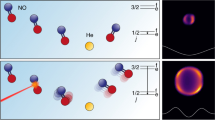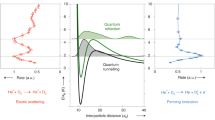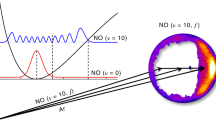Abstract
The collision dynamics between a pair of aligned molecules in the presence of a partial-wave resonance provide the most sensitive probe of the long-range anisotropic forces important to chemical reactions. Here we control the collision temperature and geometry to probe the dynamics of cold (1–3 K) rotationally inelastic scattering of a pair of optically state-prepared D2 molecules. The collision temperature is manipulated by combining the gating action of laser state preparation and detection with the velocity dispersion of the molecular beam. When the bond axes of both molecules are aligned parallel to the collision velocity, the scattering rate drops by a factor of 3.5 as collision energies >2.1 K are removed, suggesting a geometry-dependent resonance. Partial-wave analysis of the measured angular distribution supports a shape resonance within the centrifugal barrier of the l = 2 incoming orbital. Our experiment illustrates the strong anisotropy of the quadrupole–quadrupole interaction that controls the dynamics of resonant scattering.

This is a preview of subscription content, access via your institution
Access options
Access Nature and 54 other Nature Portfolio journals
Get Nature+, our best-value online-access subscription
$29.99 / 30 days
cancel any time
Subscribe to this journal
Receive 12 print issues and online access
$259.00 per year
only $21.58 per issue
Buy this article
- Purchase on Springer Link
- Instant access to full article PDF
Prices may be subject to local taxes which are calculated during checkout





Similar content being viewed by others
Data availability
Source data are provided with this paper.
References
Weck, P. F. & Balakrishnan, N. Importance of long-range interactions in chemical reactions at cold and ultracold temperatures. Int. Rev. Phys. Chem. 25, 283–311 (2006).
Naulin, C. & Costes, M. Experimental search for scattering resonances in near cold molecular collisions. Int. Rev. Phys. Chem. 33, 427–446 (2014).
Henson, A. B., Gersten, S., Shagam, Y., Narevicius, J. & Narevicius, E. Observation of resonances in Penning ionization reactions at sub-kelvin temperatures in merged beams. Science 338, 234–239 (2012).
García-Vela, A., Cabanillas-Vidosa, I., Ferrero, J. C. & Pino, G. A. The role of orbiting resonances in the vibrational relaxation of I2 (B,v′ = 21) by collisions with He at very low energies: a theoretical and experimental study. Phys. Chem. Chem. Phys. 14, 5570 (2012).
Lavert-Ofir, E. et al. Observation of the isotope effect in sub-kelvin reactions. Nat. Chem. 6, 332–335 (2014).
Bergeat, A., Onvlee, J., Naulin, C., Van Der Avoird, A. & Costes, M. Quantum dynamical resonances in low-energy CO(j = 0) + He inelastic collisions. Nat. Chem. 7, 349–353 (2015).
Jankunas, J., Jachymski, K., Hapka, M. & Osterwalder, A. Observation of orbiting resonances in He (3S1) + NH3 Penning ionization. J. Chem. Phys. 142, 164305 (2015).
Costes, M. & Naulin, C. Observation of quantum dynamical resonances in near cold inelastic collisions of astrophysical molecules. Chem. Sci. 7, 2462–2469 (2016).
Köhler, T., Góral, K. & Julienne, P. S. Production of cold molecules via magnetically tunable Feshbach resonances. Rev. Mod. Phys. 78, 1311–1361 (2006).
Wang, T. et al. Dynamical resonances accessible only by reagent vibrational excitation in the F + HD → HF + D reaction. Science 342, 1499–1502 (2013).
Vogels, S. N. et al. Imaging resonances in low-energy NO–He inelastic collisions. Science 350, 787–790 (2015).
Yang, T. et al. Extremely short-lived reaction resonances in Cl + HD (v = 1) → DCl + H due to chemical bond softening. Science 347, 60–63 (2015).
Onvlee, J. et al. Imaging quantum stereodynamics through Fraunhofer scattering of NO radicals with rare-gas atoms. Nat. Chem. 9, 226–233 (2016).
Vogels, S. N. et al. Scattering resonances in bimolecular collisions between NO radicals and H2 challenge the theoretical gold standard. Nat. Chem. 10, 435–440 (2018).
Paliwal, P. et al. Determining the nature of quantum resonances by probing elastic and reactive scattering in cold collisions. Nat. Chem. 13, 94–98 (2021).
Klein, A. et al. Directly probing anisotropy in atom–molecule collisions through quantum scattering resonances. Nat. Phys. 13, 35–38 (2017).
de Jongh, T. et al. Imaging the onset of the resonance regime in low-energy NO–He collisions. Science 368, 626–630 (2020).
Aoiz, F. J. et al. A new perspective: imaging the stereochemistry of molecular collisions. Phys. Chem. Chem. Phys. 17, 30210–30228 (2015).
Schaefer, J. & Meyer, W. Theoretical studies of H2–H2 collisions. I. Elastic scattering of ground state para- and ortho-H2 in the rigid rotor approximation. J. Chem. Phys. 70, 344–360 (1979).
Buck, U., Huisken, F., Maneke, G. & Schaefer, J. State resolved rotational excitation in HD + D2 collisions. I. Angular dependence of 0 → 2 transitions. J. Chem. Phys. 74, 535–544 (1981).
Lee, T.-G. et al. State-to-state rotational transitions in H2 + H2 collisions at low temperatures. J. Chem. Phys. 125, 114302 (2006).
Quéméner, G. & Balakrishnan, N. Quantum calculations of H2–H2 collisions: from ultracold to thermal energies. J. Chem. Phys. 130, 11430 (2009).
Balakrishnan, N., Quéméner, G., Forrey, R. C., Hinde, R. J. & Stancil, P. C. Full-dimensional quantum dynamics calculations of H2–H2 collisions. J. Chem. Phys. 134, 014301 (2011).
Sultanov, R. A., Guster, D. & Adhikari, S. K. Low temperature HD + ortho-/para-H2 inelastic scattering of astrophysical interest. J. Phys. B 49, 015203 (2016).
Jambrina, P. G. et al. Stereodynamical control of a quantum scattering resonance in cold molecular collisions. Phys. Rev. Lett. 123, 43401 (2019).
Croft, J. F. E. & Balakrishnan, N. Controlling rotational quenching rates in cold molecular collisions. J. Chem. Phys. 150, 044116 (2019).
Yang, B. et al. Quantum dynamics of CO–H2 in full dimensionality. Nat. Commun. 6, 6629 (2015).
Perreault, W. E., Mukherjee, N. & Zare, R. N. Quantum control of molecular collisions at 1 kelvin. Science 358, 356–359 (2017).
Perreault, W. E., Mukherjee, N. & Zare, R. N. Quantum controlled rotationally inelastic scattering of HD with H2 and D2 near 1 kelvin reveals collisional partner reorientation. Nat. Chem. 10, 561–567 (2018).
Perreault, W. E., Mukherjee, N. & Zare, R. N. HD (v = 1, j = 2, m) orientation controls HD–He rotationally inelastic scattering near 1 K. J. Chem. Phys. 150, 174301 (2019).
Ketterle, W. & van Druten, N. J. Evaporative cooling of trapped atoms. Adv. At. Mol. Opt. Phys. 37, 181–236 (1996).
Ni, K. K. et al. Dipolar collisions of polar molecules in the quantum regime. Nature 464, 1324–1328 (2010).
Perreault, W. E., Mukherjee, N. & Zare, R. N. Stark-induced adiabatic Raman passage examined through the preparation of D2 (v = 2, j = 0) and D2 (v = 2, j = 2, m = 0). J. Chem. Phys. 150, 234201 (2019).
Mukherjee, N. & Zare, R. N. Stark-induced adiabatic Raman passage for preparing polarized molecules. J. Chem. Phys. 135, 024201 (2011).
Mukherjee, N., Perreault, W. E. & Zare, R. N. in Frontiers and Advances in Molecular Spectroscopy (ed. Laane, J.) 1–46 (Elsevier, 2018).
Perreault, W. E., Zhou, H., Mukherjee, N. & Zare, R. N. Harnessing the power of adiabatic curve crossing to populate the highly vibrationally excited H2 (v = 7, j = 0) level. Phys. Rev. Lett. 124, 163202 (2020).
Mukherjee, N., Dong, W. & Zare, R. N. Coherent superposition of M-states in a single rovibrational level of H2 by Stark-induced adiabatic Raman passage. J. Chem. Phys. 140, 074201 (2014).
Croft, J. F. E., Balakrishnan, N., Huang, M. & Guo, H. Unraveling the stereodynamics of cold controlled HD–H2 collisions. Phys. Rev. Lett. 121, 113401 (2018).
Blatt, J. M. & Biedenharn, L. C. The angular distribution of scattering and reaction cross sections. Rev. Mod. Phys. 24, 258–272 (1952).
Arthurs, A. M. & Dalgarno, A. The theory of scattering by a rigid rotator. Proc. R. Soc. A 256, 540–551 (1960).
Diep, P. & Johnson, J. K. An accurate H2–H2 interaction potential from first principles. J. Chem. Phys. 112, 4465–4473 (2000).
Buck, U. Rotationally inelastic scattering of hydrogen molecules and the non-spherical interaction. Faraday Discuss. Chem. Soc. 73, 187–203 (1982).
Buck, U., Huisken, F., Kohlhase, A., Otten, D. & Schaefer, J. State resolved rotational excitation in D2 + H2 collisions. J. Chem. Phys. 78, 4439–4450 (1983).
Chefdeville, S. et al. Appearance of low energy resonances in CO–para-H2 inelastic collisions. Phys. Rev. Lett. 109, 023201 (2012).
Hu, M. G. et al. Direct observation of ultracold bimolecular reactions. Science 366, 1111–1115 (2019).
Even, U. The Even–Lavie valve as a source for high intensity supersonic beam. EPJ Tech. Instrum. 2, 17 (2015).
Perreault, W. E., Mukherjee, N. & Zare, R. N. Angular and internal state distributions of H2+ generated by (2 + 1) resonance enhanced multiphoton ionization of H2 using time-of-flight mass spectrometry. J. Chem. Phys. 144, 214201 (2016).
Acknowledgements
This work was supported by the US Army Research Office through the MURI programme under grant number W911NF-19-1-0283 and the National Science Foundation under grant number PHY- 2110256.
Author information
Authors and Affiliations
Contributions
Experimental data were taken by H.Z., W.E.P. and N.M., and analysis and calculations were performed by N.M. All authors participated in discussion and writing of the manuscript.
Corresponding authors
Ethics declarations
Competing interests
The authors declare no competing interests.
Peer review
Peer review information
Nature Chemistry thanks Roland Wester and the other, anonymous, reviewer(s) for their contribution to the peer review of this work.
Additional information
Publisher’s note Springer Nature remains neutral with regard to jurisdictional claims in published maps and institutional affiliations.
Supplementary information
Supplementary Information
Supplementary Figs. 1 and 2, Tables 1–5 and Discussion.
Source data
Source Data Fig. 1
Normalized, angle-resolved scattering data for both orientations at all delays.
Source Data Fig. 3
Normalized, angle-resolved scattering data for both orientations at all delays.
Source Data Fig. 5
Normalized, angle-resolved scattering data for both orientations at all delays.
Rights and permissions
About this article
Cite this article
Zhou, H., Perreault, W.E., Mukherjee, N. et al. Anisotropic dynamics of resonant scattering between a pair of cold aligned diatoms. Nat. Chem. 14, 658–663 (2022). https://doi.org/10.1038/s41557-022-00926-z
Received:
Accepted:
Published:
Issue Date:
DOI: https://doi.org/10.1038/s41557-022-00926-z



